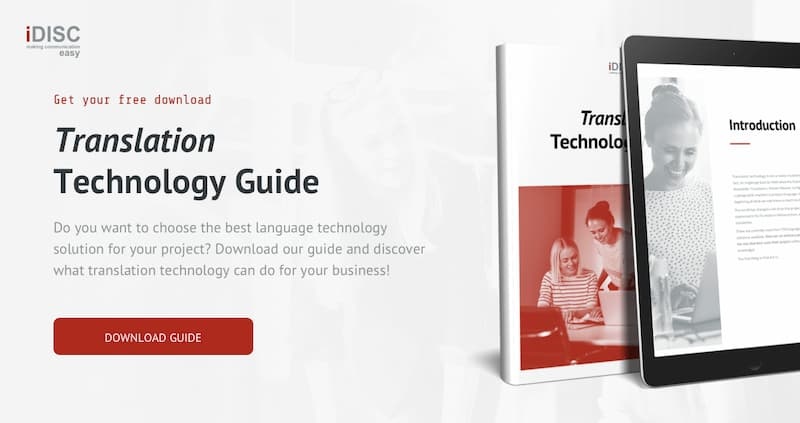Translation can be found all around us in our day-to-day lives. The market is increasingly globalized and has an urgent need for efficient communication. Any company with an international presence and any kind of business relationships beyond its borders needs translation services that allow them to effectively promote themselves in each of their target markets.
As we mentioned in our article “The future of translation technology”, this need has given rise to machine translation tools.
Over the last few decades, they have experienced exponential development that has unleashed new, much faster and more economical ways of translating compared to human translation.
This type of software went down very well with the market as a more cost-effective option for translation services. Despite this, we should be aware that, currently, these tools have certain weak points. Based on algorithms, machine translation helps to provide a general understanding of the text, but doesn’t always offer accurate translations. Double meanings, metaphors and puns still cannot be effectively translated using computers.
To counteract these weak points, an additional process was added to the chain: human postediting. In this article we’ll tell you why machine translation needs postediting. Find out with us!
What is postediting?
Postediting is the process of proofreading and correcting carried out by a human translator of a machine-translated text. The purpose of postediting is to improve the quality of the machine translation and make sure that it’s more accurate, more faithful and more fluent so that the reader can fully understand it.
When is postediting needed?
Postediting is almost always crucial for ensuring the desired quality of the translation and will be more or less thorough depending on the type of text, the goal and the use of the translation and, of course, the level of visibility it may have. A text with a complex context or, for example, a marketing slogan with a double meaning is more complicated for machine translation software. When the text type is complex, this tool tends to resort to translation techniques such as calquing and may generate very literal translations.
A medical text or the handling instructions for a nuclear reactor will demand meticulous postediting, while an FAQ page for an aftersales service will probably meet readers’ expectations, even if it does contain the occasional grammatical mistake owing to more surface-level postediting.
Factors that make postediting necessary:
- High complexity or low quality of the original text, long sentences, ambiguities, terminological inconsistencies and even linguistic errors.
- Working languages have a completely different syntax or script.
- Not enough data in the corpora that the engine is searching in relation to a particular topic or in an unusual language pair.
Human postediting is necessary to produce a more accurate and clearer translation that builds on the raw output provided by the computer. As we mentioned in our article Can machine translation replace human translation?, algorithm-based software will have a hard time matching the level of cultural sensitivity, mastery of local slang and overview of the context that a human being might have.
Lastly, it’s important to point out the speed and efficiency of a project when combining machine translation and postediting: around 25% or 30% more productive and cheaper in comparison with human translation.
Levels and processes of postediting
Levels of postediting
There are two distinct levels of postediting:
- Basic or light postediting: whereby the MT output is conserved as much as possible, making sure that no information is added or omitted, editing any inappropriate content and restructuring sentences only when the meaning has been changed. It’s commonly used when the text is not going to be published and only a general idea of the content is required. The result must be intelligible and faithful to the original, but may not be stylistically appropriate.
- Full postediting: this type of postediting is for texts with a higher profile and larger budget. Style guides, glossaries and reference documents are used. The posteditor ensures that not only the grammar and spelling are correct, but also that the terminology and client’s instructions are respected and that the format is as it should be. The aim is for the machine translation to sound as fluent as if it was translated by a human.
The postediting process
The postediting process is divided into three key general stages:
- Preliminary analysis: the language service provider determines if the source language content is suitable for MT and postediting because, as we mentioned before, the effectiveness of this process depends on the language combination, the subject matter and the style of the original text, in addition to the machine translation engine.
- Postediting test: once the project has been approved, the text is passed through the machine translation tool, and the effort and cost of postediting is assessed using an initial sample. This is to check if this method is suitable for the needs and end goal of the project itself.
- Development: in this stage, the human translator proofreads and corrects, if necessary, the machine translation, while considering all of the criteria in accordance with the level of postediting agreed with the client.
How to choose the best translation technology tool for you
As you’ve seen, there are more factors involved in this service than you may have imagined at the start. This is a job that can only be carried out by specialized personnel.
The sector professionals that provide these services are translation agencies. However, not all are at the cutting edge of translation technology.
A good professional translation company will adapt to your needs and will advise you on the type of process that is most suitable according to the text you need converted into other languages.
At iDISC we integrate linguistic services in multiple languages and with numerous tools and platforms. If you’d like more information, don’t hesitate to get in touch. We have the translation solution you need to boost your business.
We hope you’ve enjoyed this article. You can find more interesting content on our blog.
.jpg)

.jpg?width=370&height=200&name=idisc-empresa-de-traduccion-profesional%20(1).jpg)

